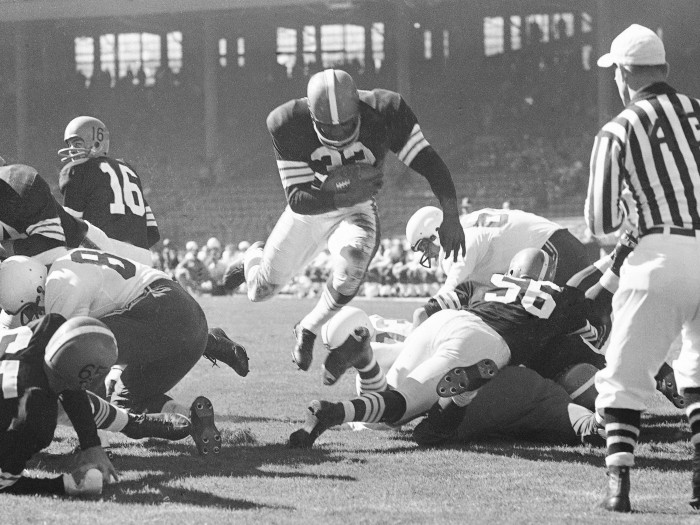One adjective describes the various manifestations of Jim Brown, who has died at 87: fearsome. He was fearsome on the football field, in action movies, as a civil rights activist and proud black American proponent of economic self sufficiency and, less happily, in the violence he displayed towards women.
His fame was built on American football, at high school, then at Syracuse University and for the Cleveland Browns in the National Football League. He was, arguably, the greatest running back the professional game has ever seen. He led the league in rushing in eight of the nine seasons he played from 1957-65, averaging over 100 yards a game, still the all time record. His strength allowed him to run through tacklers and his speed of foot could take him round them. One legendary defensive player, Sam Huff, described trying to tackle Brown: “All you can do is grab, hold, hang on and wait for help.”
Comparisons may be drawn with Babe Ruth in baseball or Don Bradman in cricket, two sportsmen who were a quantum leap better than any of their contemporaries. In one 2010 poll of 85 NFL luminaries, Brown was ranked the second best player of all time, behind only Jerry Rice, the incomparable catcher of passes (who came along later). He was also a collegiate star at lacrosse, basketball and athletics.
Brown was still in his prime at 30 when he simply gave up the sport. He was in London with a part in The Dirty Dozen when filming ran over into the NFL’s pre-season. The Browns owner, Art Modell, himself something of a football legend, threatened to fine his star for every day he wasn’t in training. That was the last the gridiron saw of Jim Brown.
But not the moviegoing public. The former footballer, with his roles in 100 Rifles and Ice Station Zebra, changed career at the start of the growing vogue for all-action films that continued in the ’70s and ’80s, witnessed by. One critic acerbically noted “the range of emotions that Brown displayed onscreen was no wider than a mail slot,” but added that he did not demean himself by playing the “comic patsy.” The feminist writer Gloria Steinem thought he could become “a black John Wayne . . . with a hint of Malcolm X thrown in”. He once told her: “I don’t want to play Negro parts. Just cool, tough modern men who are also Negroes. And not good guys all the time.”

That independent streak was already in evidence in his relationship with another free thinking black athlete, the boxer Muhammad Ali. They met in 1964, along with activist Malcolm X and the singer Sam Cooke, after the heavyweight had dethroned Sonny Liston as world champion. Three years later Brown convened what became known as the Ali Summit in Cleveland, bringing together other prominent black athletes to advise Ali, who had been stripped of his titles for refusing to be drafted in the US Army at the height of the Vietnam war.
Among them were the basketball stars Bill Russell and Lew Alcindor (later known as Kareem Abdul-Jabbar). They succeeded in stiffening the boxer’s spine, if, indeed, it ever needed stiffening. More than that, they came out in public support of Ali, thereby encouraging other athletes regardless of skin colour to take stands on issues of racial awareness.
Brown established a jobs creating mechanism in his adopted hometown to help the black community build economic power. It reflected his conviction that monetary self-sufficiency could achieve more than the civil rights movement led by Martin Luther King. (Brown said he admired King but added: “I cannot believe that freedom will be won through love.”) He later established a foundation in Los Angeles to help gang members and prisoners survive in society.

But there was also a dark side to the sportsman, specifically several arrests for assaulting women, among them his second wife Monique, which resulted in 2002 in four months in jail. His own memoirs do not present a pretty picture. Perhaps seeking to emulate basketball’s Wilt Chamberlain, who infamously claimed to have slept with 20,000 women, Brown confessed to many sex parties and he was known to boast about his sexual prowess. Monique survives him along with five children.
It was a life far removed from, but perhaps explained by, its humble beginnings. He was born James Nathaniel Brown on February 17, 1936, on St Simon’s Island, Georgia — now popular with tourists, but once home to cotton plantations using slave labour. His father, a boxer and gambler, deserted the family soon afterwards and he was raised by relatives before moving to New York to be with his mother when he was eight. That is where his sporting life took off — and his feeling that to succeed, it was necessary to be feared.
Stay connected with us on social media platform for instant update click here to join our Twitter, & Facebook
We are now on Telegram. Click here to join our channel (@TechiUpdate) and stay updated with the latest Technology headlines.
For all the latest Art-Culture News Click Here
